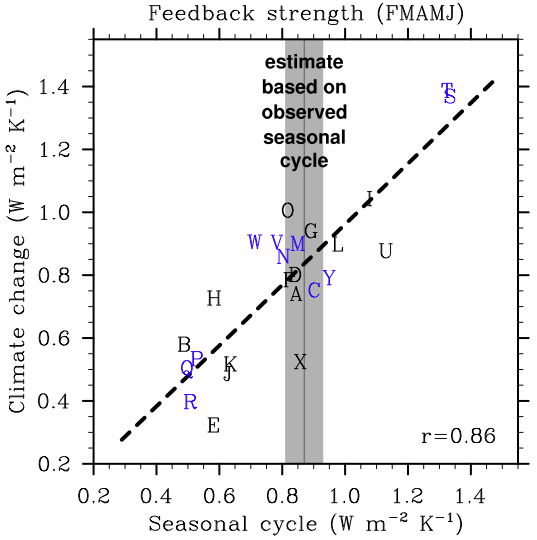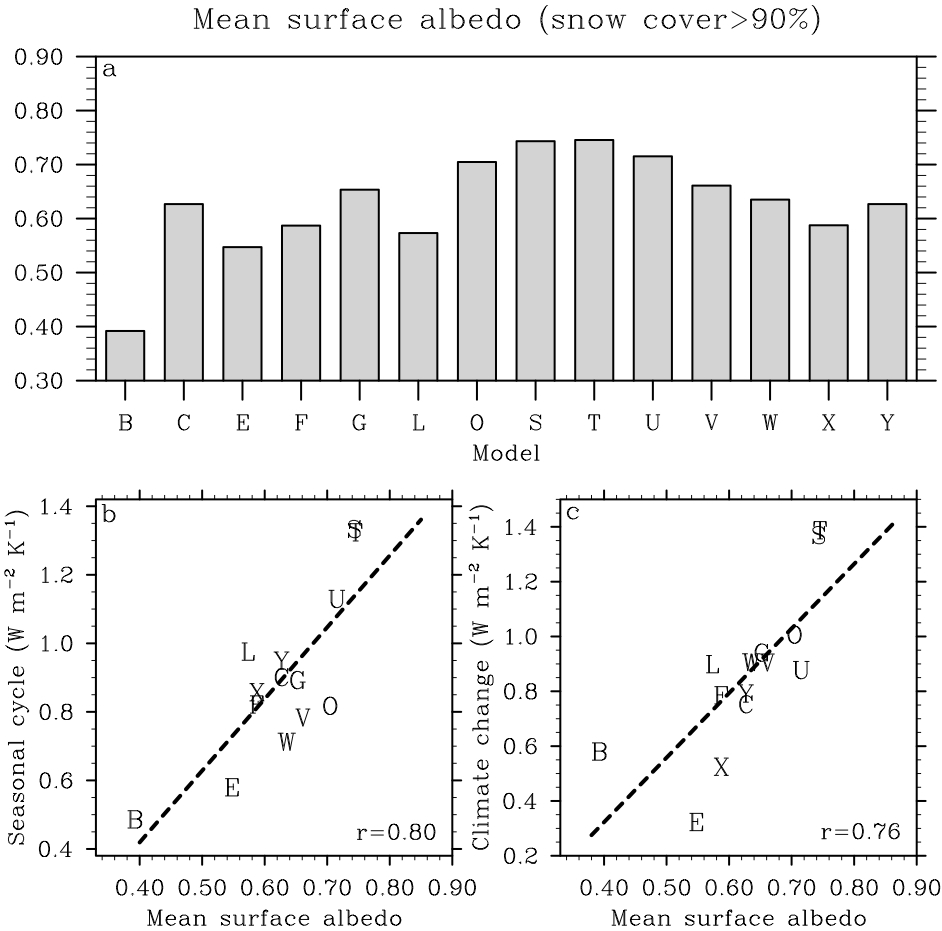
|
||||||||||||||||
|

Climate Feedbacks On the persistent spread in snow-albedo feedbackPrevious studies demonstrate that the strength of snow-albedo feedback (SAF) exhibited a threefold spread across climate change simulations participating in the Coupled Model Intercomparison Project version 3 (CMIP3). This spread introduced a big uncertainty to future warming in the NH extratropical land masses. These studies also demonstrate that there is good correspondence between the feedback strength in the contexts of seasonal cycle and climate change. Therefore, one can constrain the feedback strength in climate change using the present-day seasonal cycle. The overarching goal of this
study is to provide an update on SAF and its behavior in the
climate simulations participating in the Coupled
Intercomparison Project version 5 (CMIP5). The study has three
sub-aims: (1) To see whether the spread in SAF has narrowed in
the CMIP5 ensemble, (2) To see whether the seasonal
cycle/climate change relationship also holds in the CMIP5
ensemble, and (3) To shed light on what still might be causing
the spread in SAF. 
Fig. 1:
Scatterplot of the feedback strength averaged over 5 months
from February through June (FMAMJ) in the context of climate
change vs. the same measure in the context of seasonal cycle
in 25 CMIP5 models. The thick dashed line represents the
best-fit regression line. The observed feedback strength in
the seasonal cycle (the thin vertical line) and statistical
uncertainty of the observed estimate (the gray area) are
estimated based on MODIS surface albedo, ERA-Interim
temperature, NCAR and GFDL surface albedo radiative kernels.
Models with dynamic vegetation scheme are color-coded in
blue. As with the CMIP3 models, there is a high degree of correspondence between the seasonal cycle and climate change feedback versions of the feedback, both in their magnitude and geographical footprint (Figure 1). The ensemble-mean SAF strength is close to an observed estimate of the real climate's seasonal cycle feedback strength (the thin vertical line in Figure 1). In both contexts, SAF strength is strongly correlated with the climatological surface albedo when the ground is covered by snow (Figure 2). The inter-model variation in this quantity is surprisingly large, ranging from 0.39 to 0.75 (Figure 2). Models with large surface albedo when these regions are snow-covered will also have a large surface albedo contrast between snow-covered and snow-free regions, and therefore a correspondingly large SAF. 
Fig. 2: (a)
Regionally-averaged values of ¦Ás(90%) in the 14 CMIP5 models
with available snow cover data. (b) Scatterplot of the
feedback strength in the context of seasonal cycle vs. the
average ¦Ás(90%). (c) Scatterplot of the feedback strength in
the context of climate change vs. the average ¦Ás(90%). Dash
line in each scatterplot represents the best-fit regression
line. The spread in snow-albedo feedback has not narrowed in the CMIP5 ensemble. The ensemble-mean SAF strength in the CMIP5 ensemble is found to be realistic. SAF strength is strongly correlated with the climatological surface albedo when the ground is covered by snow. Widely-varying treatments of vegetation masking of snow-covered surfaces are probably responsible for the spread in surface albedo where snow occurs, and persistent spread in SAF in global climate models. Download
the publication (Qu and Hall 2014) describing these results in
more detail.
|
|||||||||||||||
